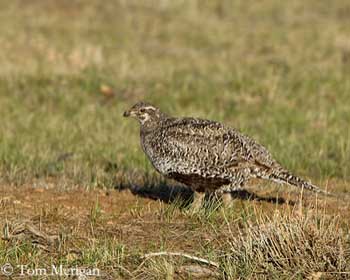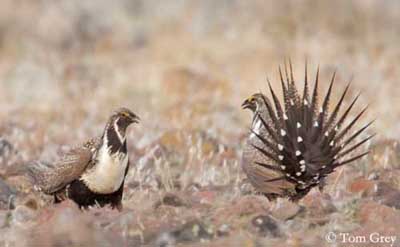
Greater Sage Grouse
Centrocercus urophasianus
Galliforme Order – Tetraonidae Family
BIOMETRICS :
Length: M : 66-76 cm – F : 48-58 cm
Weight: M : 2300-3200 g – F : 1350-1750 g
DESCRIPTION:
Greater Sage Grouse’s name comes from the habitat of this handsome bird.
This species lives mainly in Sagebrush (Artemisia tridentata) of genus Artemisia. This plant belongs to the grouse’s world, providing food, shelter, protection and nesting cover to the bird. It is an evergreen plant which leaves are available all year round.
The Greater Sage Grouse is still found in its original range, but heavy declines occurred in British Columbia and New Mexico, and also locally in California.
The species is still considered as Not Endangered by the Interior Department, and the status of the Greater Sage Grouse will be reviewed annually. However, populations are under surveillance.
Fr: Tétras des armoises
All : Beifußhuhn
Esp : Urogallo de Artemisas
Ital : Gallo della salvia
Nd : Waaierhoen
Russe : Полынный тетерев
Sd : Strålstjärtshöna
Photographers :
Tom Grey
Tom Grey's Bird Pictures
Tom Merigan
Tom Merigan’s Photo Galleries
Text by Nicole Bouglouan
Sources :
BIRDS OF THE GREAT BASIN – by Fred A. Ryser - Univ of Nevada Pr -ISBN: 0874170796
HANDBOOK OF THE BIRDS OF THE WORLD Vol 2 by Josep del Hoyo-Andrew Elliot-Jordi Sargatal - Lynx Edicions - ISBN: 8487334156
Bird Web (Seattle Audubon Society)
What Bird-The ultimate Bird Guide (Mitchell Waite)
Wikipedia (Wikipedia, The Free Encyclopedia)

Adult male has grey-brown variegated plumage, but both sexes have black belly. Male has long, stiff, pointed tail feathers. Some dark filaments occur around the neck, projecting forwards on the breast during the displays.
Male is larger than female. Upperparts are grey-brown with scaled pattern due to the white and buff feathers’ edges.
On the underparts, breast is white and shows a large white ruff. During the courtship displays, the male inflates the large greenish-yellow air-sacs situated on the breast. Belly is black. Flanks are barred black and white, extending to the undertail coverts. Underwing is white.
On the head, crown is grey and brown, as upperparts. Lores, forehead, face, chin, throat and upper neck are black. A white V-shaped line separates the throat from the neck.
We can see a yellow eye-comb above each eye, as thick eyebrow.
The strong bill is black. Eyes are brown. Legs are feathered to the toes, giving scaled effect on tarsi.

Female is smaller. She has similar plumage but she lacks the head pattern of the male, and the white ruff on the breast. Her plumage is very cryptic, providing her very good camouflage when she is incubating.

Juvenile has shaft streaks on upperparts and tail.
Immature resembles female but paler and duller.
VOICE: SOUNDS BY XENO-CANTO
Greater Sage Grouse male produces more non-vocal sounds than calls. It produces low frequency sounds during territorial and sexual behaviours. In addition, the air-sacs allow the bird to utter vocalizations such as “booming”, heard at distances of 3-4 km.
Male also produces various grunts, hisses and cackles. Some sounds can be described as “tapping” similar to water dripping, also “drum roll” made by accelerated metallic sounds almost merging together, and a sudden “pop” similar to a bottle being uncorked! At the end, the male produces rhythmic rasping panting.
The non-vocal sounds are produced by wings, tail, feet and bill during the displays, and are very variable.

HABITAT:
Greater Sage Grouse frequents grassland with Sagebrush (Artemisia tridentata) in foothills and plains. This species highly depends on the availability of this plant for food and cover.
The lek-sites occur in less-vegetated areas, but wintering and nesting sites need various sagebrush species.
RANGE:
Greater Sage Grouse is found in Western North America, from SE Alberta and Saskatchewan and SW North Dakota, S to E California, Nevada, Utah and W Colorado.
This species is mostly sedentary within its range, but altitudinal movements occur in mountainous areas. Males arrive first at leks, as soon as snow melts.

BEHAVIOUR:
Greater Sage Grouse feeds primarily on leaves of Sagebrush all year round. During winter, this food constitutes almost 100% of adult diet.
It also feeds on herbaceous legumes and weeds of numerous plant species, including cultivated legumes. Adults also consume some insects, about 2-9% of the diet. Chicks are fed with insects during the first period of their life.
Courtship displays are elaborated and occur at leks in the early morning and again in the evening, and even sometimes on moonlit nights.
Before strutting, the male adopts an upright posture with neck and head held upwards. The greenish-yellow eye-combs are displayed. Neck and chest feathers are pushed out and dark filaments elevated. The air-sacs are filled with air. Wings are slightly dropped whereas tail feathers are erected and fully fanned, displaying the beautiful pattern of undertail feathers.


When the male struts, colours, sounds and movements blend together. The display lasts several minutes during which the males moves forwards only a few steps, while it raises and lowers the air-sacs twice, after moving the wings forwards. Then it moves the wings backwards across the stiff feathers of the chest sides as the air-sacs rise. We can hear a swishing noise at this moment.
These movements display the bare greenish-yellow skin of the sacs. They suddenly inflate forwards and collapse.
During this action, the male produces sharp snaps twice after some soft coos. The entire phrase of these sounds might be: “swish-swish-coo-co-poink”.

Males also fight and perform facing-past encounters along the boundaries of two territories. They use their wings to land some blows to each other. They give harsh calls. They remain motionless, side by side, before to fight again.


Female arriving on the lek utters her quacking call. She lands at the edge of the strutting area and walks across it. She may visit the lek for some days before mating. Once she is ready, she crouches in solicitation posture and copulation occurs with the dominant cock.

REPRODUCTION:
Breeding season occurs in spring, and laying in April-May.
The nest of the Greater Sage Grouse is a shallow depression loosely lined with grass and sage leaves. It is often placed under sagebrush or clump of tall grass.
Female lays 7-8 eggs, sometimes up to 15. She incubates them during 25-27 days. The chicks are covered in cryptic down. They can fly one or two weeks later. The male does not take part in nesting duties.
The youngs leave the nest soon after hatching and are able to find their own food.
They reach their sexual maturity at 1-2 years.

DIET:
Greater Sage Grouse feeds primarily on Sagebrush leaves, and forages on the ground. This bird also consumes buds and flowers from several plants’ species. It may take some insects during summer to feed the chicks during the first week.
PROTECTION / THREATS / STATUS:
Greater Sage Grouse’s populations are threatened by habitat loss due to fragmentation and degradation.
Human developments degrade the sagebrush ecosystem with in addition, the degradation due to overgrazing, fires, herbicides and farming. Industrialization is also an important threat for the species.

